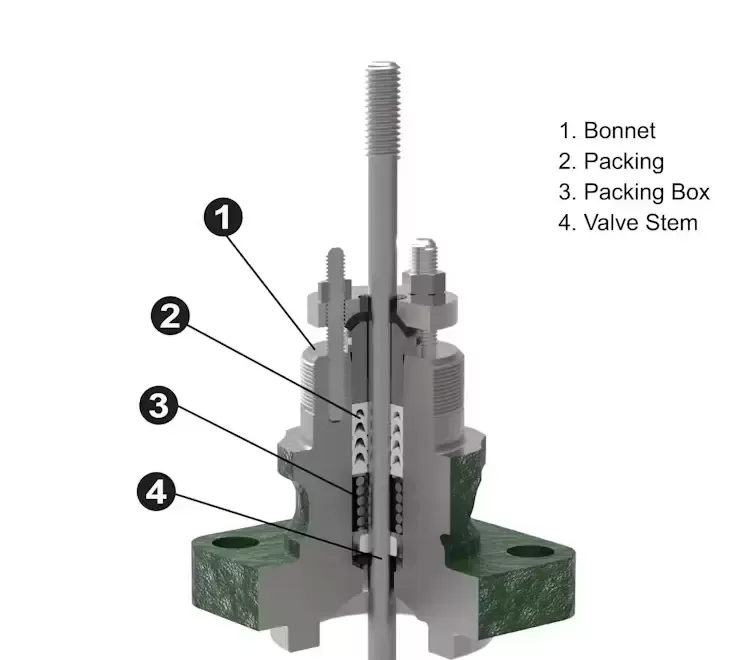Notifications

6 minutes, 30 seconds
-19 Views 0 Comments 0 Likes 0 Reviews

China Control valves generally come in two main designs: sliding stem and rotary. Sliding stem valves feature a rod, or stem, that moves up and down inside the valve body to regulate flow. Rotary valves, on the other hand, use a rotating shaft to control a disc, ball, or plug. In both designs, the valve stem or shaft must pass through the valve body, creating a potential leak path.
Valve packing serves as the sealing system around the stem or shaft at this exit point. Its purpose is to prevent process media — whether gas, liquid, or vapor — from leaking out, while still allowing smooth valve operation with minimal friction and wear.
Typically, packing consists of stacked rings made from flexible materials like PTFE (polytetrafluoroethylene) or graphite. These rings are compressed by a packing follower, flange, and bolts to form a tight seal around the stem or shaft. When properly selected and maintained, valve packing can provide many years of reliable, leak-free service.
The choice of packing material depends on operating conditions such as temperature, pressure, media type, environmental regulations, and maintenance demands. Here are the most common packing materials used in industrial control valves:
PTFE, commonly known as Teflon, is a synthetic fluoropolymer prized for its low friction, excellent chemical resistance, and non-reactivity.
Advantages:
Chemical Resistance: Resistant to almost all chemicals, including strong acids, bases, and solvents, ideal for aggressive fluids.
Low Friction: Enables smooth valve operation and reduces stem wear.
Moderate Temperature Range: Performs well up to about 250°C (482°F).
Non-Stick Surface: Simplifies adjustments and maintenance.
Disadvantages:
Limited High-Temperature Use: Degrades above 250°C, losing mechanical integrity.
Creep and Cold Flow: Can deform under constant pressure or heat cycling.
Not Suited for High-Pressure Steam: May wear quickly in such environments, especially with abrasive media.
Made from exfoliated graphite flakes pressed or braided into rings, graphite packing excels in high-temperature and pressure applications.
Advantages:
High Temperature Tolerance: Can withstand up to 450°C (842°F) in oxidizing atmospheres, higher in inert environments.
Excellent Thermal Conductivity: Helps dissipate heat, protecting the valve stem.
Low Emissions: Maintains tight seals under thermal cycling, ideal for emission-sensitive services.
Pressure Resilience: Performs well under extreme pressure.
Disadvantages:
Oxidation Risk: Can degrade in oxygen-rich, high-temperature settings.
Stem Wear: More abrasive than PTFE, potentially causing stem wear if not properly lubricated or coated.
Higher Cost: Generally more expensive, but justified by durability in severe conditions.
For extreme temperatures and pressures, metallic or composite packing systems are used. These often combine metal wire mesh, foil, or reinforced graphite, sometimes with spring-loading to maintain consistent sealing pressure.
Applications:
Refineries, power plants, nuclear facilities, and severe service valves where durability and zero leakage are critical.
Considerations:
Installation requires expertise and special tools.
Valve stems must have hard, smooth finishes to withstand abrasive effects.
Fugitive Emissions Compliance: Increasingly strict environmental regulations require packing that meets standards such as ISO 15848 and API 622. Low-emission packings (often graphite or hybrid materials) help minimize leaks.
Stem Surface Finish and Hardness: A smooth, hardened stem reduces packing wear and extends sealing life.
Packing Configuration: The number and arrangement of packing rings (sealing rings, lantern rings, wipers) affect performance and maintenance.
Live-Loaded Systems: In critical or high-cycle applications, spring-loaded packing maintains constant pressure on the packing, compensating for wear and thermal changes, thereby extending service intervals.
Even the best packing materials can fail if installed or maintained incorrectly. Key practices include:
Applying correct torque — avoiding over-tightening that causes friction or under-tightening that leads to leaks.
Following manufacturer installation guidelines carefully, including ring orientation.
Periodically checking and adjusting packing flange bolts, especially after startup.
Replacing packing as needed when signs of wear or leakage appear.
Valve packing is fundamental to seal integrity, emission control, and efficient valve operation. Whether managing corrosive chemicals, high-pressure steam, or clean-room conditions, packing selection must be tailored to your specific process requirements.
PTFE packing offers excellent chemical resistance and smooth operation in moderate conditions. Flexible graphite excels at high temperature and pressure. Metal and composite packings deliver durability for extreme applications. Combined with proper installation and maintenance, the right packing choice can greatly extend valve life and reduce operating costs.
In today’s industrial environment—where safety, compliance, and sustainability are paramount—valve packing is no longer a mere afterthought but a critical, strategic component in achieving reliable and efficient process control.Know more about Google SEO Directory

